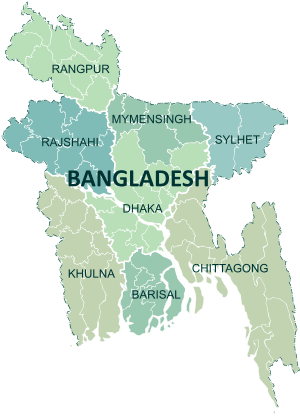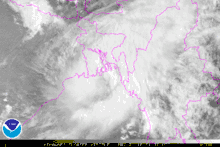2010s in Bangladesh
The 2010s was a decade of the Gregorian calendar that began on January 1, 2010, and ended on December 31, 2019. For Bangladesh this decade was characterized by political stability from continued rule of Sheikh Hasina led Awami League Government. While the country made significant economic growth in this decade, rising threat from Islamist terrorism and Rohingya refugee problem marred the progress.
Politics and National life
The decade began with Awami League government in power. The infamous BDR Mutiny has just been subdued and the trial of war crimes committed during Bangladesh Liberation War have begun. In 2010, the Supreme Court of Bangladesh reaffirmed secularism as a fundamental principle in the constitution. The war crimes tribunal mobilised public opinion in favour of secularism, which was manifested in the March 2013 Shahbag protests. In response, a huge Islamist mobilisation also took place led by the Hefazat-e-Islam group in May 2013.
The intense bickering between the League and BNP, often dubbed the Battle of the Begums, continued. The Hasina government abolished the provision of caretaker government in the constitution through the controversial Fifteenth Amendment.[1] The move was seen by the BNP as an attempt to corrupt the election process in favour of the League.
In 2013, the hard-line, right-wing, Islamic party, Jamaat-e-Islami was banned from registering and therefore contesting in elections by the High Court, citing their charter violates the constitution.[2][3] Street violence between the League, BNP and the Jamaat intensified in the run up to the general election. In 2014, the general elections were boycotted by the BNP. The elections were criticized by the United States, United Kingdom, European Union and the United Nations.[4] Sheikh Hasina was sworn in for a third tenure as prime minister.
In 2015 and 2016, Bangladesh saw increasing assassinations targeting minorities and secularists, including Hindus, Buddhists, Christians, Western and Asian expatriates, LGBT activists, Sufi Muslims, bloggers, publishers and atheists. The country's worst terrorist attack saw the death of 20 people after an upmarket restaurant was sieged by gunmen in July 2016.[5] The Islamic State of Iraq and Levant has claimed responsibility for many of the attacks, although the Hasina government insists local terror outfits are more likely to be responsible.[1] Since this attack, the Government took stricter measures against extremists as the security forces led a numerous raids on suspected militant hide-outs. The measures led to reduction in extremist attacks and fatalities.[6]

In 2017 the country faced fresh challenge from incoming Rohingya refugees. Starting in early August 2017, the Myanmar security forces began "clearance operations" against the Rohingya in northern Rakhine state — killing thousands of Rohingya, brutalizing thousands more, and driving hundreds of thousands out of the country into neighboring Bangladesh. In the first four weeks of the conflict, over 400,000 Rohingya refugees (approximately 40% of the remaining Rohingya in Myanmar) fled the country on foot or by boat (chiefly to Bangladesh) creating a major humanitarian crisis. The governments of Myanmar and Bangladesh signed a memorandum of understanding on 23 November 2017 regarding the repatriation of Rohingya refugees to Rakhine State.[7] However, till the end of the decade over 740,000 refugees remained in Bangladesh creating pressure on the country's economy and infrastructure.[8]
The 2018 General elections brought another landslide victory for the Awami League led by Sheikh Hasina. While the opposition was already weak due to key leaders being in either jail or exile, the elections were further marred by violence and claims of vote rigging.[9] However, this gave the Awami League Government stability and opportunity to complete key infrastructure projects for the country including the Padma Bridge and the Dhaka Metro Rail.
Administrative Division

With the introduction of Rangpur Division in 2010 and Mymensingh Division in 2015, by the end of the decade the country was divided eight (8) divisions shown in the table below:
| Division | Capital | Established | Area (km2)[10] | 2016 Population[10] | Density[10] | # of Districts |
|---|---|---|---|---|---|---|
| Barisal Division | Barisal | 1 January 1993 | 13,225 | 9,145,000 | 691 | 6 |
| Chittagong Division | Chittagong | 1 January 1829 | 33,909 | 31,980,000 | 943 | 11 |
| Dhaka Division | Dhaka | 1 January 1829 | 20,594 | 40,171,000 | 1,951 | 13 |
| Khulna Division | Khulna | 1 October 1960 | 22,284 | 17,252,000 | 774 | 10 |
| Mymensingh Division | Mymensingh | 14 September 2015 | 10,584 | 12,368,000 | 1,169 | 4 |
| Rajshahi Division | Rajshahi | 1 January 1829 | 18,153 | 20,412,000 | 1,124 | 8 |
| Rangpur Division | Rangpur | 25 January 2010 | 16,185 | 17,602,000 | 1,088 | 8 |
| Sylhet Division | Sylhet | 1 August 1995 | 12,635 | 11,291,000 | 894 | 4 |
As shown in the table above, these divisions were further subdivided into 64 districts.
Demographics

Based on World Development Indicators published by the World Bank[11] the population of Bangladesh grew from 150 million at the beginning of the decade to 161 million by the end. This signifies an annual population growth rate of 0.7%. Population density increased from 1156 to 1240 per sq. km. The urban population was 30.5% of the total at the beginning, which ended up at 36.6%. Dhaka, the largest city, with a population of 14.7 million, accounted for 31.8% of the total urban population by 2019. Age dependency ratio (% of working-age population) changed from 58.2% to 49.0% by the end of the decade.
The influx of Rohingya refugees had impact on the demography of Bangladesh.[12] From 25 August to 25 October 2017, around 605,000 Rohingyas arrived in Cox’s Bazar[13]. Besides, almost 203,431 Rohingya refugees were already living at Ukhiya and Teknaf Upazila of Cox’s Bazar, and they had come there during the period from July 2005 to August 2017[14]. The total number of Rohingya refugees staying in Bangladesh by the end of the decade was about 1,008,431[15].
Climate
The lowest temperature since Bangladesh's independence, at 37.4 °F (3.0 °C) was recorded in Saidpur on 10 January 2013.[16]
Natural disasters

In 2012 floods and landslides caused by heavy rain in late June, which significantly affected ten districts in the country's northern and south-eastern parts causing 131 deaths.[17] In August–September 2014, continuous rainfall in north and north-eastern Bangladesh caused flash floods in low-lying and densely populated areas affecting 2.8 million people.[18] On 21 May 2016, Cyclone Roanu made landfall near Chittagong, Bangladesh.[19] 30 people died when this cyclone hit the county,[20] and around 40,000 homesteads and business houses were damaged.[21]
In 2017 Cyclone Mora made landfall on May 31. Strong winds and storm surge battered buildings and destroyed farmlands across Chittagong, Cox's Bazar, and Rangamati. At least 20,000 houses were damaged in refugee camps for Rohingya Muslims, who were displaced by conflict in neighbouring Myanmar. Continued monsoon rain later in the year caused flooding which covered approximately one-third of Bangladesh, primarily in the northern, north-eastern, and central parts of the country.[22] Over six million have been affected, according to UNICEF, with estimates ranging as high as 8.5 million.[22][23] Property losses included nearly 700,000 damaged or destroyed homes, 4,680,000 hectares (11,600,000 acres) of farmland inundated, and thousands of miles of damaged roads.[23] On 12 June, heavy monsoon rain triggered a series of landslides and floods in Rangamati, Chittagong and Bandarban - three hilly districts of Bangladesh - and killed at least 152 people.[24]
See also
Years in Bangladesh in the decade of
References
- Van Schendel, Willem (2009). A History of Bangladesh. Cambridge University Press. p. 358. ISBN 9780521861748.
- "Bangladesh court declares Jamaat illegal | News | Al Jazeera". www.aljazeera.com. Archived from the original on 6 January 2019. Retrieved 28 December 2018.
- "EC scraps Jamaat's registration". The Daily Star. 30 October 2018. Archived from the original on 28 December 2018. Retrieved 28 December 2018.
- "Violent Bangladesh poll 'not credible'".
- "20 hostages killed in 'Isil' attack on Dhaka restaurant popular with foreigners". The Daily Telegraph. Archived from the original on 1 July 2016. Retrieved 2 July 2016.
- Sing, S.B. (21 Jan 2020). "Bangladesh: Exemplary Record – Analysis". EurasiaReview News&Analysis. Retrieved 21 Jan 2020.
- "Myanmar, Bangladesh 'sign Rohingya deal'". News.com.au. Retrieved 24 November 2017.
- "Rohingya crisis: Bangladesh will no longer take in Myanmar refugees - BBC News". BBC News. March 2019.
- Bangladesh election: Opposition demands new vote BBC News, 30 December 2018
- "Health Bulletin 2016" (PDF). Directorate General of Health Services (DGHS). p. 13. Archived (PDF) from the original on 13 June 2017. Retrieved 11 September 2017.
- "World Development Indicators". The World Bank. Retrieved 27 May 2019.
- Kudrat-E-Khuda (Babu), Michael William Scott (Reviewing editor) (2020) The impacts and challenges to host country Bangladesh due to sheltering the Rohingya refugees, Cogent Social Sciences, 6:1, DOI: 10.1080/23311886.2020.1770943
- Reported by the Cox’s Bazar District Commissioner Office
- Report on the Relief Distribution to Myanmar Nationals in Cox’s Bazar, Memorandum No. 51.01.2200.000.24.016.17–555
- Center for Policy Dialogue, 2017
- "80 dead as temperature hits record low in Bangladesh". ReliefWeb. 10 January 2013. Retrieved 31 March 2013.
- "Bangladesh: Floods and Landslides Emergency appeal n° MDRBD010 Operation update n°2". IFRC. 15 November 2012. Retrieved 28 October 2019.
- "Bangladesh: Floods - Aug 2014". ReliefWeb. Retrieved 18 December 2019.
- Mohapatra, M. "Tropical Storm Roanu Advisory No. 16 issued at 1500 UTC of 21 May 2016" (PDF). India Meteorological Department. Archived from the original (PDF) on 21 May 2016. Retrieved 21 May 2016.
- Saleemul Huq (27 May 2016). "Cyclone Roanu hits Bangladesh: a story of loss and damage avoided". International Institute for Environment and Development. Retrieved 27 May 2016.
- "20 killed, 500,000 evacuated as Cyclone Roanu hits Bangladesh". Times of Oman. Retrieved 22 May 2016.
- Steve, George (1 September 2017). "A third of Bangladesh under water as flood devastation widens". CNN. Retrieved 4 September 2017.
- "Bangladesh Humanitarian Situation Report (Monsoon Floods)". UNICEF. 1 September 2017. Retrieved 4 September 2017.
- Rima Paul and Zarir Hussain (14 June 2017). "Landslide, floods kill 156 in Bangladesh, India; toll could rise". Reuters. Dhaka/Guwahati. Retrieved 14 June 2017.